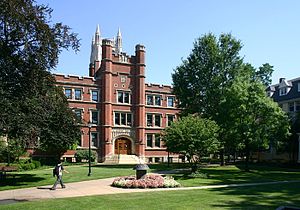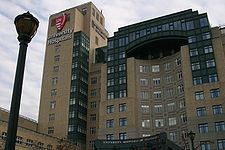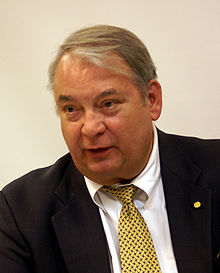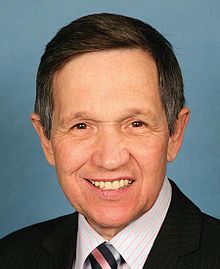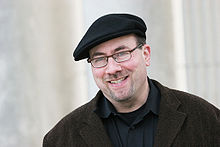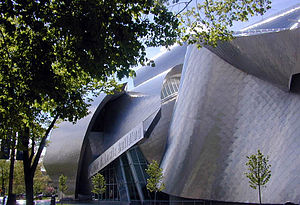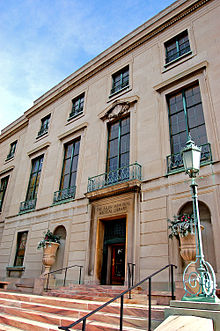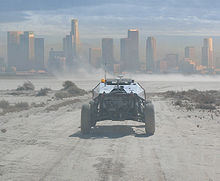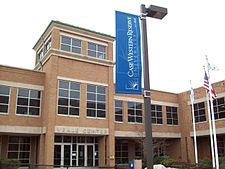- Case Western Reserve University
-
Case Western Reserve University 
Motto Thinking Beyond the Possible Established WRU: 1826
CIT: 1880
CWRU: 1967Type Private university Endowment US $1.519 billion (2010)[1] President Barbara R. Snyder Academic staff 2,400 full-time Undergraduates 4,227 Postgraduates 5,458 Location Cleveland, Ohio, U.S. Campus Urban, 155 acres (0.63 km2)[2] Colors Case Blue (PMS 294), White and Case Grey (PMS 7545)[3]
Athletics NCAA Division III UAA
19 varsity teamsNickname Spartans[4] Website www.case.edu 
Case Western Reserve University (also known as Case Western Reserve, Case Western, Case, Reserve, and CWRU) is a private research university located in Cleveland, Ohio, USA. The university was created in 1967 by the federation of Case Institute of Technology (founded in 1881 by philanthropist Leonard Case Jr.) and Western Reserve University (founded in 1826 in the area that was once the Connecticut Western Reserve). TIME magazine described the merger as the creation of "Cleveland's Big-Leaguer" university.[5]
In U.S. News & World Report's 2012 rankings, Case Western Reserve's undergraduate program ranked 38th among national universities.[6] The University is associated with 16 Nobel Laureates. Case Western is particularly well known for its medical school, dental school, law school, and its biomedical teaching and research capabilities. Case Western is a member of the Association of American Universities.
The university is approximately five miles (8 km) east of downtown Cleveland in University Circle. It is contained within a 550-acre (220 ha) area containing numerous educational, medical and cultural institutions. Case Western Reserve has a number of programs taught in conjunction with nearby institutions, including the Cleveland Clinic, the University Hospitals of Cleveland, the Louis Stokes Cleveland Department of Veteran's Affairs Medical Center, Cleveland Institute of Music, the Cleveland Hearing & Speech Center, the Cleveland Museum of Art, the Cleveland Museum of Natural History, and the Cleveland Play House.
Case Western Reserve was the site of the famous Michelson-Morley interferometer experiment, conducted in 1887 by A. A. Michelson of Case School of Applied Science and E. W. Morley of Western Reserve University. This experiment proved the non-existence of the luminiferous ether and was later cited as circumstantial evidence in support of special relativity as proposed by Albert Einstein in 1905. Michelson became the first American to win a Nobel Prize in science.[7]
Contents
History
Case Western Reserve University was created in 1967, when Western Reserve University and Case Institute of Technology (formerly Case School of Applied Science), institutions that had been neighbors for 81 years, formally federated.
Western Reserve University
Western Reserve College was founded in 1826 in Hudson, Ohio, which, at the time, was the region's most populated area and named for the Connecticut Western Reserve, out of which the area arose. The nearby city of Cleveland, located about 26 miles (42 km) to its northwest, had only begun to grow. Western Reserve College, or "Reserve" as it was popularly called, was the first college in northern Ohio.[8]
By 1875, a number of other schools had been established nearby, and Cleveland had emerged as clearly the dominant population and business center of the region. In 1882, with funding from Amasa Stone, Western Reserve College moved to Cleveland and changed its name to Western Reserve University.[9]
Case Institute of Technology
 John J.R. Macleod, 1923 Nobel Prize winner for discovering Insulin and Western Reserve University Professor of Physiology
John J.R. Macleod, 1923 Nobel Prize winner for discovering Insulin and Western Reserve University Professor of Physiology
In 1877 Leonard Case Jr. began laying the groundwork for the Case School of Applied Science by secretly donating valuable pieces of Cleveland real estate to a trust. He asked his confidential advisor, Henry Gilbert Abbey, to administer the trust and to keep it secret until after his death. The Case School of Applied Science was issued a charter by the state of Ohio in 1882-—just four short months after Case's death.
For the first four years of the school's existence, it was located in the Case family's home on Rockwell Street in downtown Cleveland. Classes were held in the family house, while the chemistry and physics laboratories were on the second floor of the barn.
Amasa Stone's gift to relocate Western Reserve College to Cleveland also included a provision for the purchase of land in the University Circle area, adjacent to Western Reserve University, for Case School of Applied Science. The school moved to University Circle in 1885.
During World War II, Case Institute of Applied Science was one of 131 colleges and universities nationally that took part in the V-12 Navy College Training Program which offered students a path to a Navy commission.[10]
Over time, the Case School of Applied Science grew to encompass a broader vision, adopting the name Case Institute of Technology in 1947 to reflect the institution's growing stature.[9]
Creating a federation
As reported by TIME magazine, although the trustees of Case Institute of Technology and Western Reserve University did not formally federate their institutions until 1967, the union had been seen by many as inevitable for decades before that.[5] The institutions already shared buildings and staff when necessary and worked together often. One such example was seen in 1887, when Case physicist Albert Michelson and Reserve chemist Edward Morley collaborated on the famous Michelson–Morley experiment. The results of their experiment served as a foundation for Albert Einstein's theory of relativity.
There had been some discussion of a merger of the two institutions as early as 1890, but those talks dissolved quickly. In the 1920s, the Survey Commission on Higher Education in Cleveland took a strong stand in favor of federation and the community was behind the idea as well, but in the end all that came of the study was a decision by the two institutions to cooperate in founding Cleveland College, a special unit for part-time and adult students in downtown Cleveland.
By the 1960s, Reserve President John Schoff Millis and Case President T. Keith Glennan shared the idea that federation would create a complete university, one better able to attain national distinction. Financed by the Carnegie Corporation, Cleveland Foundation, Greater Cleveland Associated Foundation and several local donors, a study commission of national leaders in higher education and public policy was charged with exploring the idea of federation. The Heald Commission, so known for its chair, former Ford Foundation President Henry T. Heald, issued its final report, "Vision of a University." The report predicted that federation would create one of the largest private universities in the nation, with a combined faculty larger than that of Princeton, Chicago, Stanford or Johns Hopkins.
Case Institute of Technology, a school of science and engineering, and Western Reserve University, known for its strong liberal arts and professional programs, came together in 1967 to form Case Western Reserve University.[11]
Campus
The university is approximately five miles (eight km) east of downtown Cleveland, adjacent the historical Wade Park District in University Circle, a city neighborhood and commercial center center, home to numerous educational, medical and other cultural institutions. Case Western Reserve has a number of programs taught in conjunction with nearby institutions, including the Cleveland Institute of Music, the Cleveland Institute of Art, the Cleveland Hearing & Speech Center, the Cleveland Museum of Art, the Cleveland Museum of Natural History, the Western Reserve Historical Society, Cleveland Botanical Garden and the Cleveland Play House.
Kent H. Smith Quadrangle
The Kent H. Smith Quadrangle (known to students as the Case Quad or simply as the Quad) is located south of Euclid between Adelbert Road and Martin Luther King Jr. Drive. All of the engineering buildings are located on this quad in addition to all of the natural science buildings.
Flora Stone Mather Quadrangle
The Flora Stone Mather Quadrangle (known to students as Mather Quad or simply Mather) is located north of Euclid Avenue between East Blvd., E. 115th Street and Juniper Road. Usually it is more strictly defined by the area between East Blvd, Bellflower Road and Ford Road north of Euclid Avenue. Named for the philanthropist wife of prominent industrialist Samuel Mather and sister-in-law of the famous statesman John Hay, the Flora Stone Mather Quad is home to Weatherhead School of Management, School of Law, Mandel School of Applied Social Sciences and many departments of the College of Arts and Sciences. The Kelvin Smith Library (Case Western Reserve's main library) and the Thwing Student Center are also located on Mather Quad.
North Residential Village
Situated on the northeast end of campus, the North Residential Village (NRV) is home to all Case's freshman who reside on campus. Constructed in the 1960s, the NRV consists of 12 4 floor buildings, an 11 floor "tower," a dining hall, and a building containing the NRV area office and rehearsal space for Case's music department.
Village at 115
Located along E. 115th Street, this is the newest addition to Case's residential housing units, which opened in the fall of 2005. Currently, only upper-class members may reside there. The Village (as students refer to it) consists of seven houses that surround the football field and track. Village housing is apartment style, with apartments that house one to nine people (excluding eight person units). The apartments are fully furnished. The Village is also LEED certified. Houses 1-4 & 6-7 are certified silver while house 5 is certified gold.
In February 2011, a broken pipe joint in the plumbing of House 6 caused over a 500,000 US gallons (1,900 m3) of water to flood the House's apartments, displacing upwards of 40 students. Although University Housing had crews working to repair the damage around the clock, it was over a week before any students could return, some as long as three weeks. This raised concerns about cut corners resulting in poor construction quality of the Village Houses.[citation needed]
South Residential Village
Located between Murray Hill, Cedar, Edgehill and Overlook roads, the South Residential Village (SRV) is home to most of Case Western Reserve's sophomore class. SRV is divided into two sections: Murray Hill Complex and Carlton Road Complex (known to students as bottom of the hill and top of the hill, respectively, due to the hill separating the two complexes). Carlton Road Complex includes three sophomore-only dormitories and several Greek life houses. Murray Hill Complex includes two sophomore only buildings, one sophomore and upperclassmen building, one upperclassmen-only building, and Fribley, the SRV dining hall.
Transportation
There are two main transportation options for students: For on- and near-campus transportation, Case Western Reserve University has a fleet of shuttle buses known as "Greenies," though they are currently painted blue. For longer trips, students may use the Greater Cleveland Regional Transit Authority (RTA) bus and rail system. Each undergraduate student receives an unlimited RTA pass, which is paid for via a mandatory $25 fee per semester.
Parking
Case Western Reserve University does not manage its parking lots (University Circle Incorporated manages the lots). Students, faculty, and staff still purchase permits from the university. The rates vary between approximately $30 and $120 per month.
The university owns parking garages, one at the Village at 115 and the other near the Veale Athletic Center. Permits for these two lots are purchased from the university, and cost about $600 per year,[12] excluding the summer.
Academics
In 2012 Case Western's undergraduate program was ranked 38th by U.S. News & World Report. It is also ranked at 37th for Best Value.[13] The School of Medicine ranked 22nd in research. The University is associated with 16 Nobel Laureates. Internationally, in 2010 it was ranked joint 127th alongside the University of Rochester, making it joint 41st in America.
Rankings
World Rankings
Case Western Reserve's medical school is primarily affiliated with University Hospitals of Cleveland.
World Universities 2011 2010 2009 2008 2007 2006 2005 2004 2003 Times Higher World University Rankings 65 119 90 85 60 109 88 QS World University Rankings 145 127 119 90 85 60 60 Academic Ranking of World Universities 97 87 83 78 70 69 65 51 Ranking Web of World Universities January[14] 359 284 233 Higher Education Evaluation & Accreditation of Taiwan[15] 88 82 67 79 World Rankings by QS World University Rankings in the last 7 years [16] 2011[17] 2010 2009 2008 2007 2006 2005 Overall 145 127 119 90 85 60 60 Arts & Humanities - - 298 294 307 - - Natural Sciences - - 250 252 192 - - Engineering & IT 267 262 175 149 144 - - Social Sciences - 351-400 275 239 265 - - Life Sciences 224 166 135 76 61 - - US Rankings
Undergraduate
US News and World Report National Rankings'[18]Undergraduate Area 2012 National Rank Overall 38 Business 28 Engineering 42 Biomedical Engineering 13 Best Value 37 High School Counselor Rankings 42 - In July 2010, BusinessWeek ranked Case Western Reserve #38 in the country on its list of Best Undergraduate Business programs.[19]
Graduate & Professional
US News and World Report National Rankings'[20]Graduate Area 2012 National Rank Best Business Schools 80 Engineering 45 Law 61 Medical - research 22 Nursing 15 Social Work 10 2010 US News and World Report National Rankings[21]
Medicine Area National Rank Overall 20 Biomedical Engineering 11 Family Medicine 15 Pediatrics 16 2010 US News and World Report National Rankings - Law[22]
Law National Rank Health Law 3 2009 US News and World Report National Rankings - Engineering[23]
Engineering Area National Rank Overall 46 Biomedical Engineering 12 Aerospace Engineering 30 Materials Science 25 Mechanical Engineering 36 - In 2010, BusinessWeek Ranked CWRU #14 in the country for its Part-Time MBA Program, and #21 for its Executive MBA program.[24]
National University
2007 US News and World Report National Rankings - Nursing[25]Nursing Area National Rank Overall 15 Gerontological Nursing 4 Nurse Anesthesia 11 Pediatric Nurse Practitioner 13 Family Nurse Practitioner 16 Nurse Midwifery 21 2007 US News and World Report National Rankings - Social Work[26]
Social Work National Rank Overall 10 2007 US News and World Report National Rankings - Management[27]
Management Area National Rank Non-Profit Management 7 In 2011, Washington Monthly ranked Case Western Reserve as the nation's 7th best national university for contributing to the public good. The publication's ranking was based upon a combination of factors including social mobility, research, and service.[28] In 2009, the school had ranked 15th.[29]
In 2010, The Times ranked Case Western Reserve 39th in the U.S. and 65th worldwide.[30]
In September 2009, "BusinessWeek" ranked Case Western Reserve's Weatherhead School of Management as one of the 30 best Design Thinking schools in the world.[31]
In 2008, the National Science Foundation ranked Case Western Reserve #23 in the country for producing the highest percentage of undergraduate students that go on to earn Engineering and Science Ph.Ds.[32]
The Advocate ranked Case Western Reserve University one of the top 100 LGBT-friendly universities.
Case Western Reserve ranks 13th among private institutions (26th among all) in federal expenditures for science and engineering research and development, per the National Science Foundation.[33]
Undergraduate profile
97% of enrolled students received financial aid, with an average award of $34,318.
67 percent of admitted students were in the top 10 percent of their high school class, 82 percent were in the top 20 percent and 92 percent were in the top 30 percent.[34] The SAT scores of the middle 50th percentile of admitted students were 610-700 in critical reading, 650-750 in math, and 600-690 in writing.[35] On the ACT, the middle 50% of scores was 28-32.
The most popular intended majors among the class of 2011 were engineering/computer science with 35 percent, followed by science/mathematics and pre-med/pre-dental medicine/pre-law with 18 percent and 15 percent respectively. Only 7 percent were undecided.[36]
The class of 2013 had 35 percent of students from Ohio, 56 percent from other states and 9% from outside of the United States—representing a total of 50 states and 82 countries.
Schools and programs
The university in its present form consists of eight schools:[37]
- College of Arts and Sciences
- School of Dental Medicine
- Case School of Engineering
- Franklin T. Backus School of Law
- Weatherhead School of Management
- School of Medicine
- 'University Program' established in 1843
- 'College Program' at Cleveland Clinic
- Frances Payne Bolton School of Nursing
- Mandel School of Applied Social Sciences
- School of Graduate Studies
Case also supports over a hundred 'Centers' in various fields.[38]
Naming controversy
In 2003, the university unveiled a new logo and branding campaign that emphasized the "Case" portion of its name. In 2006, interim university president Gregory Eastwood convened a task group to study reactions to the campaign. The panel's report indicated that it had gone so poorly that, "There appear to be serious concerns now about the university's ability to recruit and maintain high-quality faculty, fund-raising and leadership." Also, the logo was derided among the university's community and alumni and throughout northeastern Ohio; critics said it looked like "...a fat man with a surfboard."[39]
In 2007, the university's board of trustees approved a shift back to giving equal weight to "Case" and "Western Reserve." A new logo was chosen and implementation began July 1.[40] In an open letter to the university community, interim president Eastwood admitted that "the university had misplaced its own history and traditions."[41]
Endowment
Case Western Reserve University's endowment ranks at No. 30 among all U.S. colleges and universities. The university comes in at No. 18 for largest endowment growth over the past 20 years, experiencing an increase of 393 percent in that time (See: List of U.S. colleges and universities by endowment).
Student body
As of 2009[update], the university had 4,228 undergraduate students and 5,510 graduate and professional students. The undergraduate student body hails from all 50 states and 82 countries.
Research
Subir Gokarn (PhD alumnus), current Deputy Governor of Reserve Bank of India[42] (equivalent of U.S. Federal Reserve)
Following is a partial list of major contributions made by faculty, staff and students at Case Western Reserve:
- Case Western Reserve was the site of the famous Michelson-Morley interferometer experiment, conducted in 1887 by Albert Abraham Michelson of Case Institute of Technology and E. W. Morley of Western Reserve University. This experiment proved the non-existence of the ether, and provided circumstantial evidence to substantiate Einstein's special theory of relativity (Profs. Albert A. Michelson and Edward W. Morley, 1887).
- Albert Abraham Michelson, who became the first American to win a Nobel Prize in science, taught at Case Institute of Technology. He won the prize in physics in 1907.
- Edward Morley, in 1895, discovered the atomic weight of oxygen, the basis for calculating the weights of all other elements.
- Dayton C. Miller, in 1896, performed the first full X-ray of the human body—on himself.
- George W. Crile, in 1905, performed the first modern blood transfusion, using a coupling device to connect blood vessels.
- Roger G. Perkins, in 1912, pioneered drinking water chlorination to eradicate typhoid bacilli.
- Henry J. Gerstenberger,in 1915, developed simulated infant formula.
- Claude S. Beck, in 1935, pioneered surgical treatment of coronary artery disease.
- Frederick S. Cross, in the 1950s, developed the first heart-lung machine used during open heart surgery.
- Claude S. Beck, in 1947, performed the first successful lifesaving defibrillation of the human heart and developed cardiopulmonary resuscitation (CPR).
- Robert Kearns, in 1964, invented the intermittent windshield wiper used in most modern automobiles.
- Frederick Reines, in 1965, first detected neutrinos created by cosmic ray collisions with the Earth's atmosphere, and developed innovative particle detectors. Case Western Reserve had selected Prof. Reines as chair of the physics department based on Reines's work that first detected neutrinos emitted from a nuclear reactor—work for which Reines shared a 1995 Nobel Prize.[43]
- Eric Baer, in 1967, pioneered the materials science of polymers and created the first comprehensive polymer science and engineering department at a major U.S. university.
- Joseph F. Fagan, in 1987 developed a test for infants to identify mental retardation within one year of birth.
- Huntington F. Willard of the School of Medicine and University Hospitals of Cleveland—collaborating with colleagues at Athersys, Inc., in 1997—created the first artificial human chromosomes, opening the door to more detailed study of human genetics and potentially offering a new approach to gene therapy.
- Tshilidzi Marwala, in 2006, began work on Local Loop Unbundling in Africa. He also chaired the Local Loop Unbundling Committee on behalf of the South African Government.
- Roger Quinn[when?] developed robots such as Whegs that mimic cockroaches and other crawling insects (Case Biorobotics Lab)
In 2007, a team from Case Western Reserve participated in the DARPA Urban Challenge with a robotic car named DEXTER. Team Case placed as one of 36 semi-finalists.[44] DEXTER was the only car in the race without any seating for humans, and the only one built from scratch as a robot car.[45]
Today, the university operates several facilities off campus for scientific research. One notable example of this is the Warner and Swasey Observatory at Kitt Peak National Observatory in Arizona.
Student life
Unless students are living with a relative within 40 miles (64 km) of the university, Case Western Reserve University requires first- and second-year students to live in on-campus housing. Meal plan participation is also mandatory for first- and second-year students, with some exceptions made for religious and medical reasons. New housing for underclassmen, along with a "Greek village," bringing all the college's fraternities and sororities together with the other undergraduates, is slated to be constructed in the future.
Severance Hall is adjacent to campus, and houses the Cleveland Orchestra. The University Circle neighborhood is home to many of Cleveland's cultural institutions.
The residence halls are divided into two areas, one featuring suite-style rooms for second-year students and upperclassmen and the other featuring double and single rooms for first-year students. Both have gigabit ethernet network access and the wired network is one of the fastest that exists. A wireless campus network is also available anywhere on campus, also ranked one of the fastest by Intel in 2005. Buildings are organized into "colleges," grouping together students of similar ages and creating a sense of ownership and hall pride. New housing, known as the Village at 115, was opened in fall 2005 for upperclassmen, which features one- to nine-person, "apartment-style" residence halls that come with air conditioning, a full kitchen area, and full-sized beds.
Residence Life at Case Western Reserve University has a recent history of being liberal in its policies, including allowing co-ed suites (an option offered to non-freshman students, when requested and agreed upon by all occupants of a suite) and some co-ed floors for freshmen, as well as a three-day guest policy. Pets are allowed except for dogs, cats, ferrets and a few other small mammals, but requests are granted discussion.
Graduate students are not offered housing.
A campus shuttle runs to Coventry Village, a shopping district in neighboring Cleveland Heights. Cleveland's Little Italy is within walking distance. Legacy Village, Severance Center and Shaker Square shopping centers are all within driving distance or accessible by RTA.
Music
WRUW-FM (91.1 FM) is the campus radio station of Case Western Reserve University. Its motto "More Music, Fewer Hits" can be seen adorning the rear bumpers of many vehicles in the area. WRUW broadcasts at a power of 15,000 watts and covers most of Northeast Ohio 24 hours a day, 365 days a year.
WRUW is staffed by Case Western Reserve students and community volunteers. The station's format can be classified as non-commercial "variety."
Case Western Reserve is also home to several performing ensembles, including a cappella groups such as the Case Men's Glee Club, Case Women's Glee Club, Case in Point, Speakeasy, Dhamakapella, Bigger Than A Breadbox, and Solstice. Other ensembles include the Case/University Circle Symphony Orchestra, Camerata Chamber Orchestra, Case/CIM Baroque Orchestra, Concert Choir, Early Music Singers, Jazz Ensemble 1 and 2, Marching Spartans, Percussion Ensemble, Symphonic Winds, University Singers, Collegium Musicum, New Music Ensemble, Wind Ensemble and Chamber Music.
Case Western Reserve has two main rehearsal spaces for performing arts music majors and school ensembles. Hadyn Hall contains practice rooms with Steinway pianos, along with the department offices. Denison Hall serves as a rehearsal, practice, and teaching space for the music students and school ensembles, and is attached to Wade Commons. The Cleveland Youth Wind Symphony also rehearses in Denison Hall. Music majors take lessons at the Cleveland Institute of Music.
For performances, all students, ensembles, and a cappella groups use Harkness Chapel. The bands and orchestra also perform at Severance Hall (the on-campus home of the Cleveland Orchestra) and CIM's Kulas Hall.
Computing
Case Western Reserve had the first ABET-accredited program in computer engineering.[46]
In 1968, the university formed a private company, Chi Corporation, to provide computer time to both it and other customers. Initially this was on a Univac 1108 (replacing the preceding UNIVAC 1107), 36 bit, one's complement machine.[47] The company was sold in 1977 to Robert G. Benson in Beachwood, Ohio.
Project Logos, under ARPA contract, was begun within the department on a DEC System-10 (later converted to TENEX (BBN) in conjunction with connection to the ARPANET) to develop a computer-aided computer design system. This system consisted in a distributed, networked, graphics environment, a control and data flow designer and logic (both hardware and software) analyzer. Graphics and animation became another departmental focus with the acquisition of an Evans & Sutherland LDS-1, which was hosted by the DEC System-10, and later with the acquisition of the stand alone LDS-2.
Case Western Reserve was one of the earliest universities connected to the ARPANET, predecessor to the Internet. ARPANET went online in 1969; Case Western Reserve was connected in January, 1971.[48] Case Western Reserve graduate Ken Biba published the Biba Integrity Model in 1977 and served on the ARPA Working Group that developed the Transmission Control Protocol (TCP) used on the Internet.
Case Western Reserve pioneered the early Free-net computer systems, creating the first Free-net, The Cleveland Free-Net, as well as writing the software that drove a majority of those systems, known as FreePort. The Cleveland Free-Net was shut down in late 1999, as it had become obsolete.
It was the first university to have an all-fiber-optic network, in 1989.[49][50]
At the inaugural meeting in October, 1996, Case Western Reserve was one of the 34 charter university members of Internet2.[51]
The university was ranked No. 1 in Yahoo Internet Life's 1999 Most Wired College list.[52] There was a perception that this award was obtained through partially false or inaccurate information submitted for the survey,[53] and the university did not appear at all on the 2000 Most Wired College list (which included 100 institutions). The numbers reported were much lower than those submitted by Ray Neff in 1999.[49][54][55] The university had previously placed No. 13 in the 1997 poll.[56]
In August 2003, Case Western Reserve joined the Internet Streaming Media Alliance, then one of only two university members.[57]
In September 2003, Case Western Reserve opened 1,230 public wireless access points on the Case Western Reserve campus and University Circle.[58]
Case Western Reserve was one of the founding members of OneCleveland, formed in October 2003.[59] OneCleveland is an "ultra broadband" (gigabit speed) fiber optic network. This network is for the use of organizations in education, research, government, healthcare, arts, culture, and the nonprofit sector in Greater Cleveland.
Case Western Reserve is also known for its Virtual Worlds gaming computer lab, which opened in 2005. The lab has a large network of Alienware PCs equipped with game development software such as the Torque Game Engine and Maya 3D modeling software. Additionally, it contains a number of specialized advanced computing rooms including a medical simulation room, a MIDI instrument music room, a 3D projection "immersion room," a virtual reality research room, and console room, which features video game systems such as Xbox 360, PlayStation 3, and Wii.[60] This laboratory can be used by any student in the Electrical Engineering and Computer Science department, and is heavily used for the Game Development (EECS 290) course.
Case Western's Internet Technology Service also runs a High Performance Computing Cluster (HPCC) utilizing 976 processors over 133 computer nodes interconnected with gigabit fiberoptic ethernet. The HPCC is available for research utilizing a wide array of commercial and custom scientific software packages and computer languages including: Matlab, Mathematica, Ansys CFX Fluent and ICEM, Schrödinger, LAMMPS, Gaussian, NEURON, MCell, Python, Qhull, Sundials, Charmm/qchem, Rosetta, Gromacs, NAMD, C, C++, Fortran.
Housing
First-year students are grouped into one of three residential colleges that are overseen by first-year coordinators. The Mistletoe, Juniper, and Magnolia residential colleges were established when the "First Year Experience" system was introduced, and Cedar was created in the fall of 2005 to accommodate a large influx of new students. In the fall of 2007, Magnolia was integrated into Mistletoe. The areas of focus for each college – Cedar: visual and performing arts; Mistletoe: service leadership; and Juniper: multiculturalism – remain the same.
The residential colleges plan events together and are run by college councils that take student input and use it to plan social and community service-oriented activities.
Greek Life
Nearly one-third of the campus undergraduates are in a fraternity or sorority. There are eight sororities and sixteen fraternities currently on campus. Greek organizations are governed by an Interfraternity Council and Panhellenic Council. Recently semi-recognition has been given to a colony of Omega Tau Zeta. During the 2008-2009 school year, fraternities and sororities at Case collectively raised over $43,000 for philanthropy.[61] In September 2010, the Delta Chi Fraternity joined the Greek community. In March 2011, the Interfraternity Council at Case ceased recognition of Sigma Alpha Mu. The fraternities are:
The sororities are:
- Omega Tau Zeta
- Phi Mu
- Phi Sigma Rho
- Sigma Psi
From 1937 - 2001 there was an German-American Studentenverbindung situated in Cleveland called Corps Brandenburgia Berlin zu Cleveland. It consisted mainly of Students from the German Nobility. Togehter with the Corps Teuto-Rugia they formed the SC zu Cleveland.
Traditions
The Hudson Relays is an annual tradition at Case Western Reserve University that occurs on the last weekend before finals every spring semester. It is a relay race between teams drawn from each class year. The race is a distance of 26 miles (42 km). Originally, the race was run from Hudson, Ohio, the original site of Western Reserve University, to the present location of the school in University Circle. Since the mid-1980s, the race has been run entirely in the University Circle area. University tradition is that if a class wins the relay for each of its four years, the team will be rewarded with a champagne and steak dinner with the president of the university. The most recent class to achieve this was the class of 2011. The winning class for each year is carved on a boulder located behind Adelbert Hall.
Springfest is a day-long concert and student group festival that occurs later in the same day as Hudson Relays. The Springfest Planning Committee brings in several bands and a beer garden, student groups set up booths to entertain the student body, and various inflatable carnival-style attractions are brought in to add to the festive atmosphere. Occasionally, due to adverse weather conditions, the festival must be moved indoors, usually to Thwing Center or Adelbert Gym.
Halloween at the Farm is a tradition established in the fall of 2002. Halloween at the Farm takes place at the Squire Valleevue Farm in Hunting Valley, Ohio. Students, their families, and faculty are invited to enjoy games, a bonfire, an open air concert and hay rides. Organized by the members of the Class Officer Collective, HATF is one of the biggest events of the year. In the fall of 2009 the event was moved to the main campus and re-named "Halloween at Home" with what appeared to be far fewer activities and attendees, though it could have been due to poor weather.
Since 1974, the Film Society of Case Western Reserve University has held a science fiction marathon. The film festival, the oldest of its type, boasts more than 34 hours of non-stop movies, cartoons, trailers, and shorts spanning many decades and sub-genres.
Athletics
Case Western Reserve University has been a member of the University Athletic Association (UAA) since the early 1990s. The conference participates in the National Collegiate Athletic Association's (NCAA) Division III. The university offers 10 men's sports and nine women's sports. Two of the teams attained unprecedented success in the fall of 2006, with the women's cross country team winning the Great Lakes regional championship for the first time, and the men's soccer team earning its first-ever NCAA tournament bid.
The Case Western Reserve Men's Soccer team finished their 2006 season with a 17–2–2 record and a UAA championship. The team reached the Sweet 16 in their first-ever NCAA Division III tournament appearance and concluded the season ranked 12th in the nation.
Case Western Reserve has an excellent cross country program, as evidenced by their finishes at the NCAA national competition over the past three years. The Case Western Reserve's women's cross country team finished the 2006 season with a UAA Championship and a bid to the NCAA Championship. The Lady Spartans finished 10th in the nation. The women's team went on to finish even higher at nationals in 2007, earning a sixth-place finish at the NCAA DIII national championship. Both the men's and women's Cross Country teams qualified for and competed in the NCAA DIII national championships in 2008, with the women's team coming away with two All-Americans and a 16th-place finish. In 2009, they had two All-Americans and finished 15th. In 2010, the lady Spartans finished 19th, with one all-American, senior Justine Jeroski.
The Case Western Reserve football team finished the 2007 season with the school's first UAA Championship in football, first playoff appearance, and first playoff win against Widener University. The team lost to Wabash College in the second round. Case Western Reserve football had another undefeated regular season in 2008 but lost in the first round of the NCAA Division III playoffs to Wabash College. In 2009, the team finished its 3rd consecutive undefeated regular season and won the UAA. It earned a 3rd straight playoff appearance, losing in the first round to Trine University.
Case Western Reserve's primary athletic rival is Carnegie Mellon University.
Notable people
Nobel Laureates
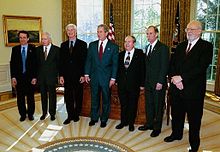 Case Western's 2003 Nobel Prize winners - Paul C. Lauterbur and Peter Agre (1st and 2nd from right) with President George Walker Bush
Case Western's 2003 Nobel Prize winners - Paul C. Lauterbur and Peter Agre (1st and 2nd from right) with President George Walker Bush
16 Nobel Laureates associated with Case Western Reserve University[62] Year Recipient Prize Details 1907 Albert Michelson Physics First American scientist to win the Nobel Prize 1923 John J.R. Macleod Medicine Discovery of Insulin 1938 Corneille Heymans Medicine Carotid sinus reflex 1954 Frederick C. Robbins Medicine Polio vaccine. Dean of CaseMed 1955 Polykarp Kusch Physics BS in physics in 1931 1960 Donald A. Glaser Physics BS in physics in 1946 1971 Earl W. Sutherland Jr. Medicine Professor and chair of pharmacology 1980 Paul Berg Chemistry PhD in 1952 1988 George H. Hitchings Medicine 1994 Alfred G. Gilman Medicine MD and PhD in 1969 1994 Ferid Murad Medicine MD and PhD in 1965. Current Trustee of Case 1994 George A. Olah Chemistry Professor and chair of chemistry 1995 Frederick Reines Physics Professor and chair of physics 2003 Paul C. Lauterbur Chemistry BS in chemistry 2003 Peter Agre Chemistry Instructor, 1978 Internal Medicine alumnus 2004 Edward C. Prescott Economics MS in operations research in 1964 Alumni Associations
Throughout the years, many higher education institutions merged to form what is now know as Case Western Reserve University. Even though the colleges do not exist individually, two alumni associations are still thriving.
Case Alumni Association
The Case Alumni Association (CAA) is one of the oldest independent alumni organization in the United States, having been organized in 1885. Membership in the Association is conferred upon all graduates of the Case School of Applied Science, Case Institute of Technology, Case School of Engineering, and the mathematics and science departments within the College of Arts and Sciences. Those who have attended any of the above institutions for at least one semester are considered members of the association. The main offices returned to campus in November 2010 at Tomlinson Hall, 2121 Martin Luther King Jr. Drive, Cleveland, Ohio, 44106.
CAA recently expanded its reach by establishing chapters (Case Clubs) in various U.S. cities, including Washington, D.C., Silicon Valley, San Diego, Los Angeles, Phoenix and Boston.[63]
CWRU Alumni Relations
Case Western Reserve University Alumni Relations is the primary alumni association for any alumni who have attend CWRU for at least one semester.
Cultural references
- The 1997 Air Force One was in part filmed on Case campus. The opening scene depicting the presidential palace of the leader of Kazakhstan was shot at Severance Hall - home of the Cleveland Orchestra adjacent to Case campus. Also seen are several landmarks of Case including the Thwing Center (the student union) and the Allen Memorial Medical Library.
- In the 1999 film Being John Malkovich, Mary Kay Place's character - Floris - is mentioned to have received "her doctorate in speech impedimentology from Case Western."
- In the 2001 film The Man Who Wasn't There, it is mentioned that the James Gandolfini character 'Big Dave Brewster' attended Case Western.
- In the 2003 book Mountains Beyond Mountains, Tracy Kidder talks about Paul Farmer choosing to apply to only two MD/PhD-anthropology programs in the nation - CaseMed and Harvard Medical School.[64]
- The 2004 Vice-Presidential Debate between then Vice-President Dick Cheney and Senator John Edwards was held on Case Western campus.[65]
- In the 2006 film The Oh in Ohio, Paul Rudd's character - Jack - becomes romantically involved with a Case student Kristin (played by Mischa Barton). In one scene, Jack drops Kristin off at the "Case Biophysics building," which is actually the Frank Gehry designed Peter B. Lewis Building at Case's Weatherhead School of Management. In this scene, a number of actual Case Western Reserve students were cast as extras, and had minor speaking roles.
- In "Drew's Cousin," a 1998 installment of The Drew Carey Show's third season, the episode's namesake mentions to Drew that she "got into Case Western."
- In 2008, the movie Flash of Genius detailed the story of Robert Kearns, who graduated from Case Institute of Technology. The movie is about how he designed the first intermittent windshield wipers, and his battle against the automobile industry to get recognition for his invention.
- In 2010, the show The Deep End on ABC features a main character, Addy Fisher, who graduated from Case Western Reserve Law School.[66]
See also
- List of Case Western Reserve University people
- Weatherhead School of Management
- Weatherhead Collection
- Association of Independent Technological Universities
References
- ^ 2009-2010 Annual Report: Financial and Statistical Highlights
- ^ USNews.com: America's Best Colleges 2008: Case Western Reserve University: Campus Life
- ^ Marketing&Communications: Case Western Reserve University
- ^ Case Western Reserve University Varsity Sports
- ^ a b TIME magazine reports on CWRU creation - http://www.time.com/time/magazine/article/0,9171,841260,00.html
- ^ "Case Western Reserve University - Best Colleges - Education - US News and World Report". Colleges.usnews.rankingsandreviews.com. 2011-09-13. http://colleges.usnews.rankingsandreviews.com/best-colleges/case-western-reserve-university-3024. Retrieved 2011-09-13.
- ^ - Case faculty 1st American to get Science Nobel
- ^ "Visiting Case: Case Western Reserve University". Case.edu. http://www.case.edu/visit/history/move.html. Retrieved 2010-02-22.[dead link]
- ^ a b "Visiting Case: Case Western Reserve University". Case.edu. http://www.case.edu/visit/about.html. Retrieved 2010-02-22.[dead link]
- ^ "Deceased Classmates in the Year 1950-1959". United States Naval Academy. 2011. http://usna50.8k.com/1950-1959.htm. Retrieved September 29, 2011.
- ^ "Visiting Case: Case Western Reserve University". Case.edu. 1967-07-01. http://www.case.edu/visit/history/fed.html. Retrieved 2010-02-22.[dead link]
- ^ "Case Parking". Parking.case.edu. http://parking.case.edu/parking/rates.htm. Retrieved 2010-02-22.
- ^ "Case Western Reserve University Rankings". Colleges.usnews.rankingsandreviews.com. 2011-09-13. http://grad-schools.usnews.rankingsandreviews.com/best-colleges/case-western-reserve-university-201645/overall-rankings. Retrieved 2011-09-13.
- ^ http://www.webometrics.info/index.html"
- ^ http://ranking.heeact.edu.tw/en-us/2010/homepage/
- ^ Case Western Reserve University World University Ranking
- ^ World University Ranking 2011
- ^ "Case Western Reserve University Rankings". Colleges.usnews.rankingsandreviews.com. 2011-09-13. http://grad-schools.usnews.rankingsandreviews.com/best-colleges/case-western-reserve-university-201645/overall-rankings. Retrieved 2011-09-13.
- ^ http://www.businessweek.com/interactive_reports/bschools_undergraduate_10rankings.html
- ^ "Case Western Reserve University Rankings". Colleges.usnews.rankingsandreviews.com. 2011-09-13. http://grad-schools.usnews.rankingsandreviews.com/best-colleges/case-western-reserve-university-201645/overall-rankings. Retrieved 2011-09-13.
- ^ US News #20 in 2010: http://grad-schools.usnews.rankingsandreviews.com/best-graduate-schools/top-medical-schools/research-rankings
- ^ Case's 2010 Law US New's ranking - http://grad-schools.usnews.rankingsandreviews.com/best-graduate-schools/top-law-schools/clinical-healthcare-law
- ^ Case's 2009 Engineering US New's ranking - http://grad-schools.usnews.rankingsandreviews.com/best-graduate-schools/top-engineering-schools/rankings
- ^ http://www.businessweek.com/bschools/rankings/
- ^ - Case's 2007 Nursing US New's ranking
- ^ - Case's 2009 Social Work US New's ranking
- ^ Case's 2007 Management US New's ranking - http://www.case.edu/president/cir/cirrankings.htm
- ^ http://www.washingtonmonthly.com/college_guide/rankings_2011/national_university_rank.php
- ^ http://www.washingtonmonthly.com/college_guide/rankings/national_university_rank.php
- ^ http://www.timeshighereducation.co.uk/world-university-rankings/2010-2011/top-200.html
- ^ Top 60 Design thinking Schools in the World
- ^ NCSES Baccalaureate Origins of S&E Doctorate Recipients - US National Science Foundation
- ^ Case ranks 13th in research: http://www.case.edu/president/cir/cirrankings.htm
- ^ http://admission.case.edu/pdfs/AdmissionGuide_Profile.pdf
- ^ Admission Guide Profile
- ^ http://www.case.edu/president/cir/fafpdfs/freshmanprofile.pdf
- ^ Case Schools and Programs - http://www.case.edu/schools/index.html
- ^ "Case Western Reserve University - Centers and Institutes". Case.edu. http://www.case.edu/schools/centers.html. Retrieved 2010-02-22.
- ^ Branding Task Group to end logo woes
- ^ Logo, Mark & Graphic Identity Task Force: Case Western Reserve University
- ^ Logo, Mark & Graphic Identity Task Force: Case Western Reserve University
- ^ - Case alum Gokarn Dep-Governor of Reserve Bank of India
- ^ University of California: In Memoriam, 1998
- ^ Team Case
- ^ Organ Donation for Robot Car | Danger Room from Wired.com
- ^ Department of Electrical Engineering and Computer Science
- ^ Chi Corporation Code Card
- ^ A Brief History of the Internet
- ^ a b "Fiber to the Dorm Room". Slashdot. June 2, 2004. http://science.slashdot.org/article.pl?sid=04/06/02/0038223. Retrieved 2007-11-10.
- ^ CWRU Magazine - Spring 1999 | F e a t u r e : The Heart of Campus
- ^ Internet2
- ^ CWRU is Yahoo's most-wired campus
- ^ The Chronicle of Higher Education
- ^ Network rankings
- ^ Whalen, Elizabeth (April 21, 2000). "CWRU plummets in Yahoo! wired rankings". The Observer. http://www.case.edu/orgs/observer/archive/00-04-21/stories/N01.html. Retrieved 2007-11-10.
- ^ June '97 @CWRU
- ^ Case joins leading-edge Internet Streaming Consortium
- ^ Case Unveils Nation's Largest Free, Public Wireless Service
- ^ "Case Western Reserve, OneCommunity Bring Free Wireless to Hopkins Airport: News Center: Marketing and Communications: Case Western Reserve University". Blog.case.edu. 2009-12-18. http://blog.case.edu/case-news/2009/12/18/wirelessairport. Retrieved 2010-02-22.
- ^ EECS Department: Virtual Worlds Laboratory
- ^ "Discover Greek Life at Case! - Case Office of Greek Life". Studentaffairs.case.edu. http://studentaffairs.case.edu/greek/. Retrieved 2010-02-22.
- ^ "Nobel Prize winners". CWRU. 2010-03-17. http://www.case.edu/corporate/nobellaureates.html. Retrieved 2010-03-17.
- ^ "Case Alumni Association - Home". http://www.casealum.org. http://www.casealum.org/. Retrieved 2010-02-22.
- ^ Kidder T. Mountains Beyond Mountains: The Quest of Dr. Paul Farmer, A Man Who Would Cure the World. Random House (2004). p64.
- ^ Cheney and Edwards Vice presidential debate: Vice Presidential Debate – Vice President Cheney (R) and Sen. John Edwards (D)
- ^ Case Law on The Deep End – Hulu - The Deep End: Pilot - Watch the full episode now
External links
Coordinates: 41°30′15″N 81°36′30″W / 41.50416°N 81.60845°W
Campus Adelbert Hall · Allen Memorial Medical Library · Flora Stone Mather Quadrangle · Kent H. Smith Quadrangle · Case Medical Center · Mather House · Rainbow Babies & Children's Hospital · University Circle · Warner and Swasey Observatory · Village at 115
People Student Life Athletics · The Observer · Student body · WRUW-FM
Traditions University Athletic Association Brandeis Judges • Carnegie Mellon Tartans • Case Western Reserve Spartans • Chicago Maroons • Emory Eagles • NYU Violets • Rochester Yellowjackets • Washington University Bears
Association of American Universities (AAU) Public - Arizona
- University of California
- Colorado
- Florida
- Georgia Tech
- Illinois
- Indiana
- Iowa
- Iowa State
- Kansas
- Maryland
- Michigan
- Michigan State
- Minnesota
- Missouri
- State University of New York
- North Carolina
- Ohio State
- Oregon
- Penn State
- Pittsburgh
- Purdue
- Rutgers
- Texas
- Texas A&M
- Virginia
- Washington
- Wisconsin
Private Canadian Universities Research Association United States - Alabama
- Arizona
- Arizona State
- Boston University
- Brown
- Buffalo
- University of California
- Caltech
- Carnegie Mellon
- Case Western Reserve
- Chicago
- Colorado
- Columbia
- Cornell
- Duke
- Florida
- Florida State
- Harvard
- Hawaii
- Houston
- IIT
- Illinois at Urbana–Champaign
- Illinois at Chicago
- Indiana
- Iowa
- Iowa State
- Johns Hopkins
- LSU
- Maryland
- MIT
- Michigan
- Michigan State
- Minnesota
- Nebraska
- New Mexico
- New Mexico State
- North Carolina
- North Texas
- Northeastern
- Northern Illinois
- Northwestern
- Notre Dame
- Ohio State
- Oklahoma
- Oregon
- Penn State
- Pittsburgh
- Princeton
- Purdue
- Rice
- Rochester
- Rockefeller
- Rutgers
- SMU
- South Carolina
- Stanford
- Stony Brook
- Syracuse
- Tennessee
- University of Texas
- Texas A&M
- Texas Tech
- Tufts
- Tulane
- Utah
- Vanderbilt
- Virginia
- Virginia Tech
- Washington
- Washington University
- Wayne State
- William & Mary
- Wisconsin
- Yale
International Categories:- Association of American Universities
- Association of Independent Technological Universities
- Case Western Reserve University
- North Central Association of Colleges and Schools
- Universities and colleges in Cleveland, Ohio
Wikimedia Foundation. 2010.


